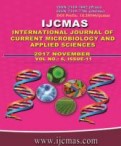


 National Academy of Agricultural Sciences (NAAS)
National Academy of Agricultural Sciences (NAAS)

|
PRINT ISSN : 2319-7692
Online ISSN : 2319-7706 Issues : 12 per year Publisher : Excellent Publishers Email : editorijcmas@gmail.com / submit@ijcmas.com Editor-in-chief: Dr.M.Prakash Index Copernicus ICV 2018: 95.39 NAAS RATING 2020: 5.38 |
Knowledge of genetic divergence provides us a sound scientific basis for the selection of genotypes to be used in hybridization programme for further improvement. A field experiment was conducted during Rabi season, 2014-15 at Main Experiment Station (Vegetable Research Farm), N. D. U. A. & T., Kumarganj, Faizabad (U.P.) India, to estimate genetic divergence among the 30 genotypes of ajwain for ten characters by using Mahalanobis D2 analyses. The genotypes under study grouped into six clusters. Among the six clusters, cluster IV was the largest, comprising of 7 genotypes. The inter-cluster distance was larger than the intra-cluster distance suggesting wider genetic diversity among the genotypes of different groups. The maximum and minimum intra- cluster distances were found in cluster IV (83.61) and cluster VI (29.15), respectively. The inter- cluster D2 values was maximum between the cluster III and IV (198.03) indicating wide range of genetic diversity between these two clusters. The maximum cluster mean was observed in cluster VI for seed yield/plant (36.44) along with number of branches/plant (10.45). The characters like test weight (32.41%), number of umbellets per umbel (20.46%) and days to maturity (17.01%) contributed maximum to genetic divergence and hence played a major role in improvement of ajwain.
 |
 |
 |
 |
 |